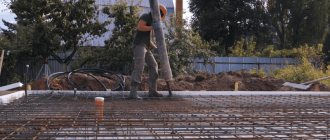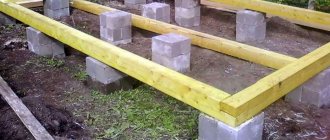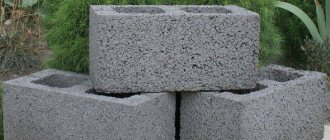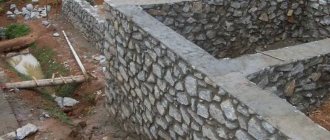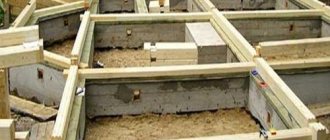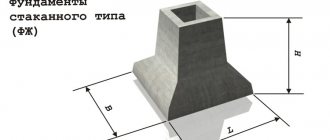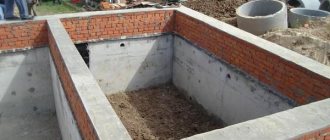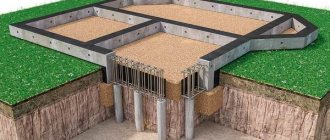For safe storage of a car, the optimal type of construction is a garage. If there is an increased depth of soil freezing, the building is located on problematic soil, or the proximity of aquifers, a solid foundation must be laid under the walls. For such conditions, the best option for the foundation structure is a monolithic slab. When constructing a slab foundation for a garage, you should correctly calculate the thickness and follow the pouring rules when performing work. Let's consider the application features, design features of a solid slab, as well as the technology of its construction.
Application of a monolithic foundation slab and installation of a slab base
When deciding on the choice of foundation for a garage made of blocks, brick or stone, vehicle owners have to choose among different types of foundations.
A garage must have a reliable foundation and a solid floor
Possible options:
- a strip-type foundation that follows the contour of the garage building. It is formed by pouring concrete into the formwork, with a reinforcement cage pre-placed in it. The strip design is used on stable soils with deep aquifers;
- monolithic reinforced concrete slab, poured into formwork to the required thickness over the entire area of the garage. The slab foundation is also called floating. It has proven itself positively on problematic soils, ensuring the stability of the garage during soil deformation;
- a prefabricated version of the slab formed from standard panels laid on a crushed stone bed. To construct a prefabricated foundation, lifting equipment is required. The composite version is inferior to the monolithic one in terms of strength properties;
- rubble concrete foundation made along the perimeter of the garage walls. The basis of the foundation structure is rubble stone, which is laid on a bed of crushed stone and a sand layer and filled with cement mortar. This foundation design is not used when groundwater is close to the ground.
Among these types of foundation foundations, the best foundation for a garage is a slab. When the soil moves, it moves together with the ground, ensuring the stability of the structure and the integrity of the garage walls. The slab not only prevents uneven shrinkage of the garage, but also reliably waterproofs the room.
A slab is the best foundation for a garage
The one-piece foundation design has proven itself in various conditions:
- on weakened soils with high moisture concentration;
- when located close to the zero level of aquifers;
- on bulk soils with a high content of fine sand;
- with an increased tendency of the soil to deform as a result of freezing.
The main feature of the solid base is the increased size of the foundation sole, which ensures:
- uniform distribution of the load from the mass of the structure on the soil;
- smoothing out soil reaction associated with frost heaving;
- preventing local shrinkage of garage walls;
- eliminating the possibility of crack formation.
It is important to correctly determine the thickness of the monolithic slab and the depth of its base. In this case, it is necessary to take into account:
- the nature of the soil at the construction site;
- depth level of aquifers;
- load characteristics of the foundation;
- total weight of the garage building;
- the presence of altitude differences on the site;
- characteristics of the building materials used;
- climatic conditions.
In various conditions, the one-piece foundation design has proven itself positively.
Depending on the mass of the garage structure and the nature of the soil, the slab foundation is made with different levels of depth relative to the zero mark.
Possible options:
- not buried. It is used for lightweight buildings and is constructed at ground level after leveling the surface and clearing the site;
- slightly buried. Designed for stone garages, it is displaced deep into the soil by 40-50 cm and does not provide for the possibility of constructing a basement;
- recessed Used to build garages with attics. The base of the base slab is located at the level of soil freezing.
Regardless of the depth level of the solid slab, the monolithic foundation has the same structure. It is formed in the form of a multilayer slab, each level of which solves specific problems.
The slab includes the following tiers:
- waterproofing. It is formed by laying geotextile fabric on the leveled ground, separating the crushed stone-sand bedding and the soil;
- damping. It is formed by a cushion of sand-crushed stone mixture in which drainage is placed. The bedding compensates for the reaction of soil deformations;
A slab foundation is made with different levels of depth depending on the weight of the garage building
- sub-concrete. Increases the load-bearing capacity of the slab, levels the surface of the damping pad and represents a thin layer of concrete;
- moisture-proof. Prevents saturation of the monolithic slab with ground moisture, and prevents water leaks from the hardening concrete solution;
- thermal insulation. It is formed from sheet or granular heat insulator, allowing to reduce the amount of heat loss;
- strengthening. It increases the strength of the slab. Reinforcing bars with a cross-section of 12-14 mm are used, tied into a lattice using knitting wire;
- carrier. The final layer of the slab, made of concrete, takes the weight of the structure and proportionally distributes the mass over the area of the base.
To form a slab of given dimensions, an important structural element is used - stationary or collapsible formwork. It is mounted along the contour of the platform, gives the concrete mass the necessary configuration and prevents the loss of cement laitance during the concrete hardening process.
When constructing a monolithic foundation, it is important to follow the sequence of placement of layers to ensure the necessary margin of safety of the slab and ensure the durability of the base. Remember that each tier of the platform performs specific functions and is constructed in strict accordance with technology requirements.
Each tier of the platform performs certain functions
Universal foundation - monolithic slab
Any non-professional who decides to build a garage with their own hands is faced with the difficulty of choosing a foundation.
Almost everyone asked the question: “is there really no universal foundation?” In fact, in this situation it is quite difficult to talk about universality. But the least problems, in the presence of negative factors, will be caused by a foundation slab, in other words, a floating foundation. A floating foundation is a monolithic reinforced concrete slab that is placed under a building. This design distributes loads well and is optimal for a one-story garage without additional recesses (inspection hole, cellar). A slab foundation can even be used as a floor, but it is better to insulate it and make an additional coating.
The monolithic slab is called a “floating foundation” for a reason. It is directly related to its properties: when the soil settles or cracks due to severe frosts, the foundation and building do not deform. The structure, together with the slab, shrinks smoothly, which ensures durability and practicality of the structure.
Pros and cons of a floating foundation
A monolithic slab for a garage has many positive aspects, thanks to which its use is so widespread.
- A monolithic slab is not afraid of geological problems. Such a foundation is not afraid of shrinkage, swelling and erosion.
- High groundwater is not an obstacle for a garage built on a monolithic slab. Provided proper waterproofing and compliance with technical standards, the garage will always be dry.
- A slab foundation can act as a floor, which will simplify the work and save a little money. As a rule, insulation is done on top of the floating foundation and the main covering is laid.
- The design of the reinforced concrete slab allows you to create a heated floor in the garage. This is an excellent alternative to uneven and wasteful heating.
- The solidity of the structure provides 100% protection from rodents and insects that can penetrate the ground and floor.
Well, the main advantage, of course, is the simplicity of the design itself. Even if you have never done anything like this, after carefully studying the issue, you can make a reliable floating foundation for your garage with your own hands, which will serve you for many years without any complaints.
Although this design has few disadvantages, it still has them. Firstly, such a foundation excludes the construction of an inspection hole or cellar. But not everyone needs them. Secondly, installing a monolithic slab involves a large consumption of reinforcement and concrete, which is quite expensive. Again, the reliability and durability are worth the expense.
Summing up the review of the main qualities and properties of a floating foundation, we can say that this is the most practical and simple solution for problem areas.
Design options
A monolithic slab for a garage is universal in that there are several design options. You can use the one that best suits your requirements and financial capabilities.
1 Regular
A conventional slab is a solid base, 10 to 60 cm thick, located in a recess or on the surface.
Reinforced at the edges
This design can be located at any convenient depth (1.5-2.5 m). A monolithic slab reinforced at the edges is a flat base with stiffening ribs located around the perimeter. Using formwork, the ribs are also filled with concrete, forming walls. Another reinforced concrete slab on reinforcement is formed on top. As a result, we get a solid foundation with a basement that can be used as a basement or cellar. Due to its complexity and high cost, this design is not used very often in private garages, but almost all high-rise buildings are built according to this principle.
Lightweight (grid)
This design allows you to save a little on materials, although it is only suitable for garages made of lightweight materials (wood, foam blocks). The lightweight foundation is not a solid slab, but a lattice with cells (from 1 to 1.5 m). It would be a stretch to call such a foundation monolithic; it is more like a strip foundation. But nevertheless, with such a foundation the load is distributed much more evenly, and the building structure itself is more stable.
Slab foundation for a garage - advantages of a monolithic foundation
The foundation, made in the form of a solid reinforced concrete slab, is superior in operational characteristics and load capacity to other types of foundations. The monolithic structure has a set of undeniable advantages and at the same time has a number of disadvantages. Let's start with the advantages.
Main advantages:
- long period of use. A properly executed multilayer platform is a durable structure that can be used for a century;
- simplicity of arrangement. Due to the limited scope of excavation activities, it is not difficult to independently form a shallow slab;
- increased load-bearing characteristics. The increased size of the sole allows you to build a massive garage on problematic soil;
- economical design. There is no need for additional arrangement of the floor, which is formed during the process of pouring the reinforced concrete slab;
- increased moisture resistance. The multilayer design prevents the absorption of ground moisture and protects the garage from dampness;
- resistance to ground movements. The slab ensures the integrity of garage walls during frost heaving of the soil, moving along with the soil.
Durable design - properly executed multi-layer platform
In addition, the reinforced concrete platform does not exert increased pressure on the soil, is not subject to deformation and prevents shrinkage. With a platform thickness of a couple of tens of centimeters, it reliably fixes the position of the garage building on problematic soils.
Let's look at the disadvantages of the design. Main disadvantages:
- increased costs for the construction of a slab foundation associated with the acquisition of the required volume of sand and crushed stone for preparing concrete and forming a cushion;
- the impossibility of constructing a solid slab on a sloping site. With an increased slope, the thickness of the platform increases, which leads to an increase in the estimated cost of construction;
- the problematic nature of building a cellar in a garage.
Despite the increased costs of purchasing building materials and other disadvantages, vehicle owners are attracted by the reliability and durability of the foundation structure, as well as the resistance of the slab to natural factors.
Construction of a conventional shallow foundation for a garage
If you plan to equip a small inspection hole in the garage with your own hands, then the depth of the foundation strip should be at least one meter. This will ensure high load-bearing capacity of the base and prevent deformation of the base during excavation work.
Let us dwell on the important points of construction work that will prevent the negative effects of heaving soil and moisture on the foundation strip and the walls of the building:
- It is necessary to insulate the foundation on the formwork from the outside with sheets of extruded foam or polystyrene foam along the entire height of the tape, including the base. We choose the thickness of the penoplex based on the climate of the region;
- a blind area (50 cm wide) with foam insulation will prevent freezing of the soil and deformation of the brick and concrete walls of the garage;
- storm drainage will ensure water drainage from the foundation;
- additional drainage at the base level is necessary if the groundwater level is high on the site;
- It is necessary to install high-quality waterproofing of the concrete strip using penoplex or ordinary sheets of roofing material. You can also use bitumen waterproofing.
If you do not skimp on waterproofing and drainage work, then the stability, strength and durability of the foundation is guaranteed.
What materials are the foundations for a garage made from?
The list of materials for the construction of a slab base includes:
Tools for getting the job done
- concrete mortar made from gravel, Portland cement, water and fine sand;
- concrete mixer, which allows you to prepare an increased volume of solution and increases the efficiency of mixing;
- materials used to provide thermal and waterproofing protection of a monolithic foundation;
- moisture-resistant plywood, boards and beams used for the construction of formwork structures;
- reinforcement bars with a grooved cross-section used to assemble the load-bearing frame;
- annealed wire necessary for binding reinforcement blanks into a frame.
The following tools are also required to complete the work:
- shovels and buckets;
- carpentry tools for assembling formwork;
- wire tying device;
- vibrator for compacting concrete mass;
- building level;
- grinder, equipped with a circle for metal.
When preparing to carry out construction activities, you should take care of personal protective equipment for the respiratory organs, eyes and hands. Having prepared everything you need, start building the slab.
Carrying out work on pouring the foundation
Concrete slab for a garage - technology for creating a reinforced concrete base
The process of creating a slab foundation for a garage box includes the following steps:
- Preparatory activities.
- Performing markings.
- Preparing the pit.
- Construction of a damping cushion.
- Installation of formwork.
- Performing waterproofing.
- Assembly and installation of reinforcement grid.
- Filling the formwork with concrete mixture.
- Caring for concrete after pouring.
Let us dwell on the specifics of each stage of construction work.
We are preparing to create a reliable foundation for the garage building - preparatory work
Before construction begins, the following preparatory measures should be completed:
Preparatory activities should be completed before construction begins
- Choose a place for construction.
- Make sure that there are no utilities under the future garage.
- Carry out geodetic surveys.
- Calculate the weight of the garage box.
- Perform strength calculations.
- Calculate the thickness of the foundation.
- Develop a foundation sketch.
- Determine the need for building materials.
- Estimate the upcoming amount of costs.
After completing the preparatory work, proceed to the next stage.
Marking the area according to the size of the garage
Marking work is carried out on a previously prepared site. To do this you need:
- Remove stones and plant roots.
- Uproot stumps.
- Remove existing waste.
- Level the surface.
Marking work is carried out on a previously prepared site.
Marking is carried out using pegs and twine. Procedure:
- Drive pegs into the corners of the future foundation.
- Stretch a string between them.
- Check the size matches.
A maximum deviation of the difference in the length of the diagonals is allowed up to 20 mm.
Extracting soil for the pit and backfilling with sand and crushed stone
Guided by the positions of the hammered pegs, prepare a pit:
- Remove a layer of fertile soil.
- The soil is removed to a specified depth.
- Level the surface of the pit.
- Cover the bottom of the pit with geotextile fabric.
- Fill in a layer of sand mixed with crushed stone.
- The damping pad is compacted.
To increase the efficiency of compacting the bedding, the crushed stone-sand layer should be moistened. If it is necessary to remove moisture, drainage lines are laid before the cushion is formed. According to technology requirements, it is allowed to place utilities in the damping layer.
Backfilling the cushion with sand and crushed stone
Installation of formwork around the perimeter of the pit and waterproofing
For the manufacture of formwork, panels made of various materials are used:
- moisture-resistant plywood;
- wooden boards;
- metal sheets.
Shields are assembled from the available material, and then the following work is performed:
- The formwork is installed along the contour of the future slab, rising above the soil level by the calculated amount.
- Vertical posts are driven in and braces are installed to ensure the immobility of the formwork frame.
- The inner surface of the formwork structure is waterproofed using sheet roofing felt or polyethylene.
Having completed the installation of the formwork, a heat-insulating layer is laid and the structure is strengthened with a reinforcement cage.
Formwork is installed along the contour of the future slab
Assembly of reinforcement mesh and installation of a frame made of reinforcement
To reinforce the slab, a number of operations must be performed:
- Cut blanks from steel reinforcement.
- Connect the elements with tying wire.
- Place the frame in the formwork on special stands.
To prevent corrosion of metal rods, a constant distance from the reinforcement to the concrete surface should be ensured, equal to 30-40 mm. Do not forget that knitting the reinforcement of a monolithic slab provides more reliable fixation of the elements compared to using electric welding.
Foundation slab for a garage - pouring a slab foundation
The pouring of a monolithic foundation slab is carried out with a self-prepared solution or a purchased concrete mixture.
The prepared solution is used to fill the monolithic foundation slab
When performing work, it is important to comply with the following requirements:
- do not allow interruptions when filling the formwork with concrete mixture;
- start pouring from the corner areas, evenly distributing concrete over the entire area;
- thoroughly compact the concrete using a vibrator;
- level the concrete surface after removing air inclusions.
To ensure the strength of the foundation, it is necessary to use concrete marked M350 and higher.
Protecting the concrete layer from cracking - the final stages of work
At the final stage of work, the surface of the slab should be reliably protected from cracking:
- evenly moisten the surface of the concrete mass at elevated air temperatures;
- Lay a plastic film over the hardening concrete to prevent moisture loss.
Maintaining constant humidity promotes normal hydration reactions. Concrete gains operational strength within 28 days. After the foundation has hardened, begin building the walls of the garage building.
Foundation cushion installation
Before starting construction, trenches for a strip base or a foundation pit for a monolithic one are dug in a cleared and marked area. All loose soil is removed and the bottom of the trench is leveled. Then a layer of sand, gravel or concrete is formed.
Cushion for a strip foundation made of sand
Diagram of the installation of a sand cushion under a strip foundation.
To create a layer of sand under the base you will need:
- Sand with coarse or medium grain without various inclusions (especially clayey ones).
- Geotextiles or roofing felt will serve as a barrier against groundwater.
- Level, pegs and rope.
- Vibrating plate or homemade rammer.
Before installing the layer, all loose soil is removed from the bottom of the trench. Geotextiles or roofing felt are laid on its bottom with an overlap (10 cm). These materials will prevent sand from mixing with the soil. Also, when backfilling, an important point is to respect the horizon line. To do this, use pegs and rope to set the desired level.
Sand is poured on top of the laid material.
Each layer is then compacted using a vibrating plate. Tamping is carried out until no traces remain on the surface. Each layer should be approximately 10 cm high.
When forming, usually its height is normally 20-30 cm. To calculate the maximum allowable height, you need to triple the width of the tape. The created layer should resemble a trapezoid in its cross-section. Its narrowest part should be located at the bottom (a tilt angle of 30 degrees is desirable).
The organization of this layering option is relevant:
- If leveling of the bottom of a trench or pit is required.
- If you need to replace soil with strong heaving with sand.
Crushed stone pillow
To install a crushed stone cushion under a strip foundation, the following material is required:
Construction of a rubble concrete foundation.
- River sand with coarse grains.
- Crushed stone or gravel 20-40 mm in size.
The formation of a crushed stone base begins with a layer of sand. Its thickness is 10-15 cm. The resulting layer must be wetted and the compaction process is carried out using the same devices as in the previous version.
Crushed stone about 20 cm thick is poured onto the compacted layer. In total, the height of crushed stone and sand should be 30-40 cm. The crushed stone is compacted. As a result, the crushed stone must lie strictly in a horizontal plane. The width of the interlayer is equal to the width of the planned base tape with the addition of 15-20 cm on one and the other side.
This simple version of the base for a strip foundation will withstand the load from a structure of several floors.
Concrete foundation cushion
This version of the device is more expensive, but also justified. If formed correctly, the foundation with a concrete pad will become a solid foundation for the future structure. To build it you will need:
- Concrete.
- Crushed stone or gravel.
- Boards.
- Vibrating plate or homemade rammer.
- Metal rods.
To begin with, crushed stone 10 cm high is placed at the bottom of a leveled trench under a strip foundation. It is compacted using a homemade device or a vibrating plate. Then formwork from boards is mounted on the crushed stone base. Its height should be equal to the height of the future pillow (up to 30 cm). The width of the layer is plus 15 cm on both sides.
To increase strength, the pillow is reinforced (strengthened) using metal rods with a diameter of 8-12 mm. A frame is created from the reinforcement material by welding or tying structural elements together.
Concrete is poured into the formwork with a metal frame. The brand of this material will depend on the weight of the future structure. After the pouring process, the concrete is compacted using a deep vibrator. Rods 40-60 cm long are inserted into the prepared base for further coupling of the concrete base with the foundation. They should protrude half their length above the surface.
When forming a concrete preparation for the construction of a lighter structure, crushed stone can be replaced with sand. Form a layer of 10 cm and water it with water to compact it. The following manipulations are identical to the above-described version of the device.
For a strip foundation, a concrete pad will become a solid foundation with a fairly long service life. If properly organized, it will withstand the significant weight of the structure and serve as an excellent foundation.
Every type of pillow has a right to exist. Despite the fact that the formation can be carried out from different materials, if the process is carried out correctly, any of the above options will be a reliable support for the future structure.
How to strengthen the foundation for a garage
In certain situations, the foundation needs to be strengthened. When using massive blocks for the construction of walls, building a garage with an attic, as well as when it is necessary to store a heavy vehicle, care must be taken to strengthen the monolithic slab using additional reinforcement ribs.
To form stiffeners, it is necessary, when constructing a pit, to prepare a pit in the following places:
- along the perimeter of the foundation;
- inside the foundation structure.
To strengthen the slab, a trench measuring 40x50 cm is made. Reinforcement connected to the common power circuit is placed in the pit. Then concreting is done. To strengthen the foundation structure, it is advisable to concrete the slab 15-20 cm wider than the contour of the future garage.

